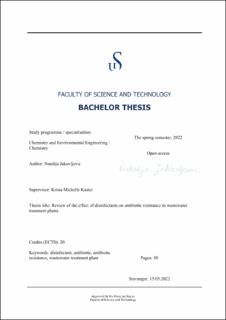| dc.contributor.advisor | Kaster, Krista Michelle | |
| dc.contributor.author | Jakovljevic, Natalija | |
| dc.date.accessioned | 2022-07-08T15:54:15Z | |
| dc.date.available | 2022-07-08T15:54:15Z | |
| dc.date.issued | 2022 | |
| dc.identifier | no.uis:inspera:108213656:35963364 | |
| dc.identifier.uri | https://hdl.handle.net/11250/3004107 | |
| dc.description.abstract | Antibiotic resistance (AR) has been identified by the World Health Organization (WHO) as one of the biggest threats to human health, due to the increased and unrestricted antibiotic use in humans and animals. In addition, there is growing concern that substances with antimicrobial properties, such as disinfectants coming from industry and housings, functions as selective agents in the proliferation of AR mainly due to co- and cross-resistance. Wastewater treatment plants (WWTPs) provide several different environmental conditions potentially favoring the selection of ARGs and thereby their spread in the environment. Although WWTPs show removal effectiveness of antibiotics and disinfectants from the wastewater influents, they fail to eliminate antibiotic resistance genes (ARGs). For that reason, WWTPs are among the main sources of the release of antibiotic resistant bacteria (ARB) and ARGs into the environment. Even though the distribution of different ARGs in WWTPs has been deeply investigated, the ecology and the molecular mechanisms underlying the selection of specific ARGs, especially those associated with disinfectants, are still poorly understood.
The review aims at investigating the effect of disinfectants in WWTPs on AR. First the mechanisms of action of different types of disinfectants on bacteria, as well as some of the resistance mechanisms bacteria possess against these chemicals, are described. The impact antimicrobial agents have on ARGs have been studied and linked to potential spread of these genes between bacterial genomes. WWTPs act as a final barrier to prevent the release of ARGs into the environment. Therefore, it is important to understand the different treatment processes and the effect of disinfectants in the treatment facilities on the spread and release of ARGs. The results of several studies support the hypothesis that the use of disinfectants can contribute to AR. Additionally, they show that present day WWTPs need some further improvements and induction of some more advanced treatment methods to increase their removal efficiency of antimicrobial agents and ARGs. This review concludes that more research is required to fully determine the effect of disinfectant use on the fate of ARGs in WWTPs. | |
| dc.description.abstract | Antibiotic resistance (AR) has been identified by the World Health Organization (WHO) as one of the biggest threats to human health, due to the increased and unrestricted antibiotic use in humans and animals. In addition, there is growing concern that substances with antimicrobial properties, such as disinfectants coming from industry and housings, functions as selective agents in the proliferation of AR mainly due to co- and cross-resistance. Wastewater treatment plants (WWTPs) provide several different environmental conditions potentially favoring the selection of ARGs and thereby their spread in the environment. Although WWTPs show removal effectiveness of antibiotics and disinfectants from the wastewater influents, they fail to eliminate antibiotic resistance genes (ARGs). For that reason, WWTPs are among the main sources of the release of antibiotic resistant bacteria (ARB) and ARGs into the environment. Even though the distribution of different ARGs in WWTPs has been deeply investigated, the ecology and the molecular mechanisms underlying the selection of specific ARGs, especially those associated with disinfectants, are still poorly understood.
The review aims at investigating the effect of disinfectants in WWTPs on AR. First the mechanisms of action of different types of disinfectants on bacteria, as well as some of the resistance mechanisms bacteria possess against these chemicals, are described. The impact antimicrobial agents have on ARGs have been studied and linked to potential spread of these genes between bacterial genomes. WWTPs act as a final barrier to prevent the release of ARGs into the environment. Therefore, it is important to understand the different treatment processes and the effect of disinfectants in the treatment facilities on the spread and release of ARGs. The results of several studies support the hypothesis that the use of disinfectants can contribute to AR. Additionally, they show that present day WWTPs need some further improvements and induction of some more advanced treatment methods to increase their removal efficiency of antimicrobial agents and ARGs. This review concludes that more research is required to fully determine the effect of disinfectant use on the fate of ARGs in WWTPs. | |
| dc.language | eng | |
| dc.publisher | uis | |
| dc.title | Review of the effect of disinfectants on antibiotic resistance in wastewater treatment plants | |
| dc.type | Bachelor thesis | |
